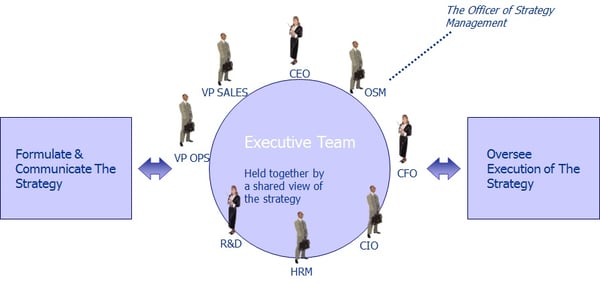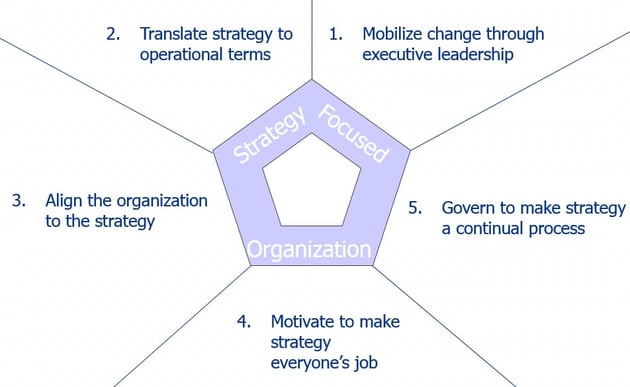It is not a simple task to give direction and reach strategic decisions that are carried through by all parties involved. This is especially the case in large organizations as well as smaller businesses. On top of this, chosen strategies often suffer a loss in traction over time and are quickly forgotten and put aside. Group structures, new stakeholders and drastic changes to the working environment require a ‘strategic dialogue’ on a quasi-permanent basis.
A ‘strategic dialogue’ is a discussion where all the parties openly discuss insights, decisions made and share collectively supported ideas that result in effective action. Such action is then carried through and the success is measured.
 |
"Performance management can provide a significant contribution to maintaining a competitive advantage." |
The vision of an organization, is ideally a shared philosophy about the optimal way in which an organization functions. This is known at every level and is translated into individual behavior or performance at work. If the vision of an organization is merely “delegated” by top management to employees or worse, communicated via an ambiguous and generic campaign, the vision will never carry enough weight to motivate.
In order to ensure perfect congruence between the organization and its employees, managers must organize sessions wherein employees actively participate in internalizing the overall vision of the company. Top management may know the long term goals of the organization, a deeper understanding of the vision however may be solely understood and translatable by experts in the field. In changing business environments, the organizational learning process is a necessary skill in order to realize strategic change.
Why OPM?
CEO’s stated in 2010 that performance management will be the greatest challenge in the coming years. Lack of strategy, leadership, clear responsibilities, poor communication, poorly formulated plans, a dysfunctional organizational structure and evolutions in the direction that are not correctly followed through top the list for reasons for failure of a venture. The rapidly changing economic situation and the accompanying uncertainty are also beginning to have substantial impact. Furthermore, executives are facing increasingly critical challenges. Therefore, there is a need for an all-encompassing management system. High performance organizations make sure that all their management systems focus on one clear system, better known as ‘Organizational Performance Management’.
The goal of OPM is to define a process that motivates and inspires managers and employees to perform to the best of their ability. The resulting boost in performance will help to accomplish the organizational goals through an effective and efficient implementation of the organization strategies. Performance management that is clear and measurable can significantly contribute to a lasting competitive advantage. It also encourages managers to take goal-oriented action to ensure the realization of the chosen strategy.

You can find out how a similar structure influences the roles of managers in the presentation you can download below. It contains, for example, the functions and roles of all those involved in strategy management.
How is the success of performance management
measured?
Goal-oriented improvements are brought about by an expertly developed reporting mechanism. Measuring is simply the means of acquiring the necessary data and only plays a supporting role. The presence of indicators is all too often seen as the only solution, whilst it is merely the starting or finishing point. The real power of measurement is its ability to generate fact-based insights. True improvement can only be realized when these insights are reported and translated to well-reasoned and appropriately directed action. This is why it is crucial to resist the tendency to measure everything. It is more important to know that what is measured is considered purely functional and that the subsequent action is most important.
The so-called Balanced Scorecard was developed in the early '90s in the Harvard Business School. A Balanced Scorecard defines the strategy of an organization in measurable terms and helps to monitor its realization. Throughout the years the Balanced Scorecard has served as a way to measure the strategic management process of an organization.
The main objective of the Balanced Scorecard is to motivate everyone to propose improvements in line with the goals and strategy of their branch and to subsequently execute these in practice. Even the best strategy map or Balanced Scorecard serves no purpose if such concepts are not carried out in practice. The Balanced Scorecard complements the logic of the strategy. Empirical research shows that the following perspectives are often addressed: finances, customers, internal business processes, people and learning. The balanced scorecard is not entirely ‘balanced’, the performance metrics are organized and defined by the 4 aforementioned perspectives. The value of the balance is only made clear when the Balanced Scorecard is institutionalized in a continuous process of strategic focus and structure.
You can use these 5 components as the basis of the management process:
- Clarify the mission and create a consensus within the strategic objectives;
- Communicate the strategy to the whole organization, making sure to highlight the methods of control;
- Quantify goals, determine the points of measurement and allocate resources;
- Motivate everyone within the organization to translate the strategy into their daily tasks accordingly;
- Govern and institutionalize in order to make the strategy a continual process.

The Balanced Scorecard makes sure that a strategic dialogue is communicated on a more or less permanent basis. One of the consequences of these strategic dialogues is the exchange of visions, opinions, frames of reference and knowledge of the strategic topics between the members of the organization.
Want to learn more on performance management?



